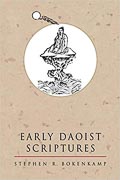start > Klassieke teksten > Late Han tot Tang > tekst
靈書紫文 Lingshu ziwen
Engelse titel: Numinous Writings in Purple Script
The Lingshu ziwen is een van de belangrijkste originele Shangqing geschriften. In de Daoistische canon (Daozang) is deze tekst verspreid over vier teksten. Engelse vertalingen zijn te vinden in Bokenkamp 1997.
Isabelle Robinet vat de teksten als volgt samen.
The first text (DZ 639) opens with the story of the composition of the Lingshu ziwen by the Azure Lad (Qingtong), who in Shangqing scriptures plays the role of mediator between divine and human beings. It continues with three methods dealing with subtle physiology and involving visualizations, incantations, and the absorption of talismans (fu). The first method teaches how to ingest the pneumas (qi) of the sun and the moon; the adept invokes the secret names of the Emperors of the Sun and the Moon, envisioning their pneumas and absorbing them with a talisman. The second method aims at “securing the three hun” (ju sanhun 拘三魂) and “controlling the seven po” (zhi qipo 制七魄). Since the hun are fond of freely flying away, the adept should control them by encircling his body with a red pneuma summoned from his heart. The po, however, are malevolent; one should avert their threats by imprisoning them through the visualization of the Jade Women (yunü) and the four directional animals (siling), which in Shangqing texts often form a sacred guard around the practitioner. These techniques are complemented by a third practice, consisting of invocations to the Three Primes (sanyuan) or Three Ones (sanyi) who reside in the three Cinnabar Fields (dantian), and in animating the god of the Mysterious Pass (xuanguan). This method is designed to replace the sexual practices of the Celestial Masters (Tianshi dao) and is related to embryonic breathing (taixi), as the Mysterious Pass is “the passageway that joined the placenta to your viscera when you were first born”.
The second text (DZ 255) gives the recipe for the Elixir of Langgan, named after a mythical tree that grows on Mount Kunlun. This method, lying between operative alchemy and “astro-alchemy,” joins the compounding of an elixir with the absorption of astral efflorescences; the product likely was not meant for actual ingestion.
The third text (DZ 442) is devoted to a description of the apocalypse. It deals with Li Hong, the Sage Lord of the Latter Age (the present cosmos), who comes at the end of the world to save the “seed-people” (zhongmin), i.e., the adepts who have gained access to the Lingshu ziwen, respect moral rules, and bear the physical marks of transcendence enumerated in the text.
The fourth and last text (DZ 179) is one of the few Shangqing sources that list ethical and ritual prohibitions. (Robinet in Pragadio 2008)
Indeling tekst
De overgeleverde tekst is in de daoistische Canon (de Daozang) verspreid over vier teksten:
1. 皇天上清金闕 帝君靈書紫文上經 Huangtian Shangqing Jinque dijun lingshu ziwen shangjing -Superior Scripture of the Numinous Writings in Purple Script of the Imperial Lord of the Golden Portal of the August Heaven of Highest Clarity (DZ 639)
2. 太微靈書紫文琅 玕華丹神真上經 Taiwei lingshu ziwen langgan huadan shenzhen shangjing -Divine, Authentic, and Superior Scripture of the Elixir Efflorescence of Langgan, from the Numinous Writings in Purple Script of the Great Tenuity (DZ 255)
3. 後 聖 道 君 列 紀 Housheng daojun lieji - Chronicle of the Lord of the Dao, Saint of the Latter Age (DZ 442)
4. 太微靈書紫文仙忌真記上經 Taiwei lingshu ziwen xianji zhenji shangjing - Superior Scripture of the Interdictions for Immortals Recorded by the Real Men, from the Numinous Writings in Purple Script of the Heaven of Great Tenuity (DZ 179)
Literatuur en vertalingen
Hieronder kunt u een selectie maken van de verschillende publicatievormen en de taal. Ik beperk me tot vier taalgebieden (Nederlands, Engels, Frans en Duits). De meeste literatuur is overigens engelstalig. U kunt bij teksttype ook apart de vertalingen selecteren en U kunt desgewenst ook een specifieke auteur zoeken.
Boeken 1 tot 1 van de 1
Boeken 1 tot 1 van de 1

